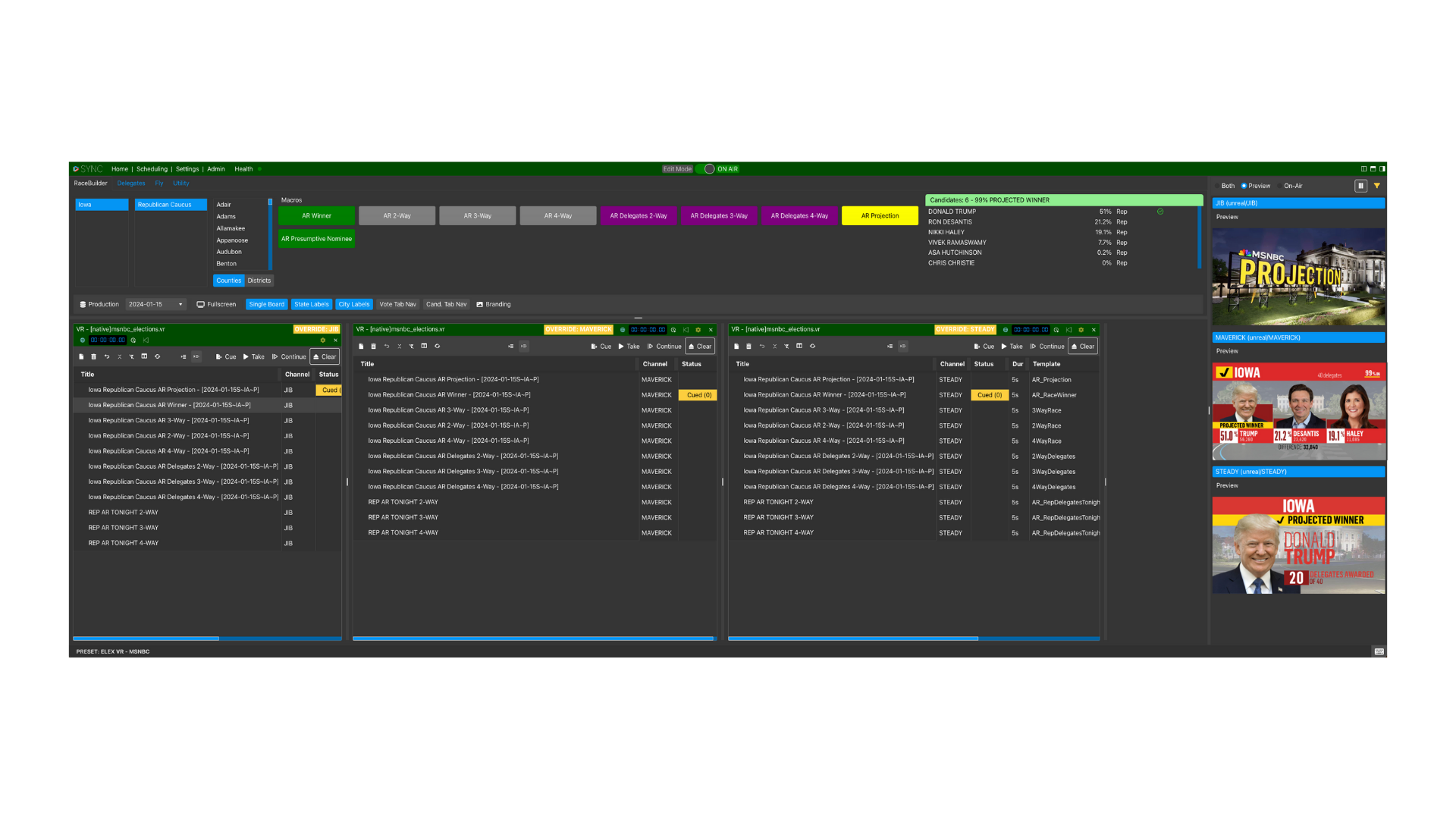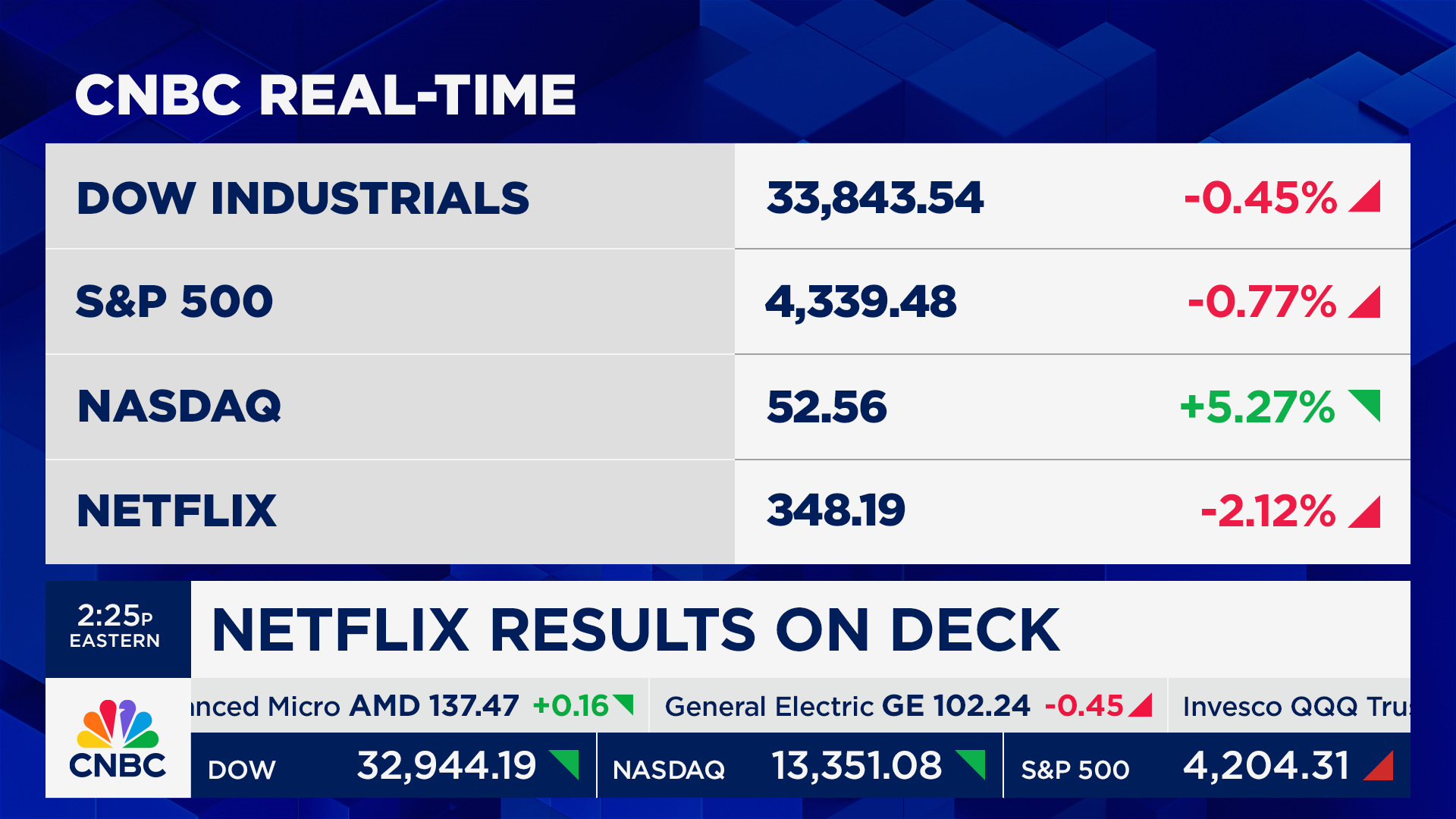Key CNBC Redesign Tech To Pay Dividends Across Entire News Group
The home-grown control tech behind the look also will revamp election control and beyond

NEW YORK—As the 2024 election season began in earnest on Jan. 15 with the Iowa Caucus, NBC News is deploying a new web-based controller of its own making designed to enable its editorial team to respond faster and more easily to changing vote totals, generate on-air graphics and keep viewers better informed as the primary and general election votes unfold.
Sync, under development since December 2022, is an agnostic controller that producers, playback operators and technical directors are using to control the network’s Vizrt render engine.
“Sync really unifies the way that we look at not only the control room workflow, but also the content creation workflow,” says Marc Greenstein, senior vice president of Design & Production for NBCUniversal News Group.
The initial goal for Sync was to replace the network’s aging election control system. Another priority was to optimize video and graphic playback, he says. However, even before the 2024 election season began, the network realized its December 2023 launch of a CNBC redesign, would be the perfect fit for the new controller.
While perhaps not immediately apparent, the financial network and election coverage share some production commonalities. Both frequently depend on a mix of playlists for any given show. Although the MOS rundown is almost always the priority, there are additional “shared playlists,” in the words of Greenstein, that address important fast developments on an ad hoc basis.
“I call them ‘shared playlists,’ meaning somebody from the desk is saying, ‘Here are the top 10 movers today. Let's make a playlist and have everyone easily be able to access that,” he says. “For elections, there’s something similar.”
For next-day election coverage, a MOS-based playlist will drive most of the presentation. “But then there'll be either the user-based playlist or the auto-generated playlist on the night itself, meaning the user may say, ‘Hey, let me make a playlist of battleground counties in Iowa. Here are the five counties that we’re watching closely,” explains Greenstein.
The professional video industry's #1 source for news, trends and product and tech information. Sign up below.
“It [the user-based playlist] allows them quick access as the director and the control room teams decide what content they want on air at what moment. Obviously, it’s the same thing for CNBC.”
Sync and Workflow
More broadly, Sync will unify control across the entire NBC news group, opening up several workflow options and beyond, says Greenstein.
From a workflow perspective it enables the network’s editorial teams to select various templates, organize data in a way that speeds time to air and save presets so that as a story pivots throughout the day coverage can evolve more easily, he says.
“The problem with traditional automation is that it is totally dictated by a rundown and by MOS abstracts. You definitely have reduced flexibility,” says Greenstein. “The core of Sync was to break from that and say, ‘We can very closely follow the rundown, or we can break [that and allow user-generated playlists on the fly].’”
From an organizational point of view, Sync brings other benefits. Not relying on a single computer in a single physical location thanks to its web-based design offers a degree of disaster recovery as well as the flexibility to work remotely if some unforeseen circumstance makes it impossible to work from the studio, as was the case during COVID, he says.
While currently used to command the render engine, Sync also can control Singular.live graphics and other HTML platforms, as well as additional graphics devices and tape machines. Even future production switcher control isn’t off the table, he says.
“What we tried to create with Sync was an accordion,” says Greenstein. “If you're doing a really complicated show that requires multiple operators to do things on the fly that aren't part of a planned rundown—meaning there needs to be instantaneous decision making, Sync can scale to have two operators, five operators, 10 operators, all controlling the different parts and pieces hooked into it.”
Conversely for smaller, more formatted shows, Sync could one day be used to execute a more automated control approach. “That is absolutely on the roadmap of things that we’re going to dig in and consider,” he says.
CNBC Redesign
Robert Poulton, vice president and global creative director at CNBC, headed up the redesign of the financial network’s on-air look. Work began in June 2020 on the new design. The network selected Troika Media Group, an outside design and advertising firm that it had worked with in the past, to assist with the design. (Troika filed for bankruptcy in December 2023.)
Deciding what to keep and what to eliminate took about a year, says Poulton. “There are so many elements that are on our screens all the time. So many of them are just fed with data. We were not just building graphics. We were building graphics that are fed with something that adjusts and moves.”
Among the key design goals was developing a clean, minimal aesthetic that delivers actionable information and language seamlessly to viewers so that they can be comfortably engaged 24/7. Poulton and Troika developed a new grid foundation with a square shape acting as the root of the financial network’s design language. The network chose a design placing show branding and time zone clocks above the CNBC logo. Selected colors were bold and reflected the brand’s legacy.
The design also incorporated an updated CNBC logo aligned with the new peacock colors as well as a logo font treatment using Tinker, a font named after former NBC chairman and CEO Grant Tinker.
Augmented and virtual reality (AR and VR) use is also part of the redesign, especially to enhance storytelling during earnings season, says Poulton.
“I will say, we've just launched the look. The child's born. Now we've got to raise it, and I think that we'll add on as we as we go along. But really the idea of AR and VR in general is not [that it’s] just a pretty thing to look at, but how can it help us tell the story in a better way?” Poulton asks, rhetorically.
For election coverage, Sync made its debut controlling some of the network’s AR and virtual graphics used to cover the Iowa Caucus, says Greenstein.
Greenstein recalls seeing the new design for the first time. “It was so simple and clean, but it’s also so complicated,” he says. “We really just came to the conclusion; we need to take Sync and pivot to launch this on CNBC to give it [the design] the capability Robert was looking for but not make the workflow a tremendous burden either on the operators or producers.”
Steve Fastook, senior vice president of Technical Operations at CNBC, echoes Greenstein’s observation. “It [the simplicity of CNBC’s redesign] created a lot of complexity under the hood,” says Fastook. “[With] a typical graphics device, an operator would play out graphics, and the TD [technical director] would key them.
“Well, every single graphic in our system goes back and forth with the production switcher. So, sometimes the production switcher fires Viz and tells it to do an effect. Sometimes Viz tells the switcher. ‘Hey, make this move, change this priority and then play out.’ It’s a very close, intermixed operation. It's quite complicated. But with Sync on top of it all, it's really simple for the operators.”
Deploying Sync first for the rollout of CNBC’s new design should pay dividends for the network’s coverage of the 2024 elections, Greenstein predicts.
“The great part is what we learned from doing CNBC. We're now back into elections with a lot of that knowledge,” he says. “I think you're going to see our election coverage over time get a little more dynamic from the things that we picked up in approaching the CNBC project.”

Phil Kurz is a contributing editor to TV Tech. He has written about TV and video technology for more than 30 years and served as editor of three leading industry magazines. He earned a Bachelor of Journalism and a Master’s Degree in Journalism from the University of Missouri-Columbia School of Journalism.





